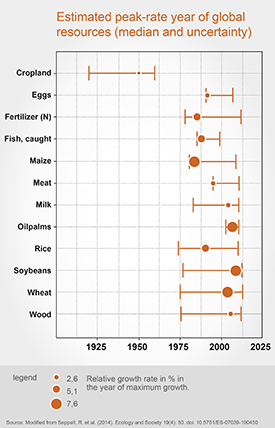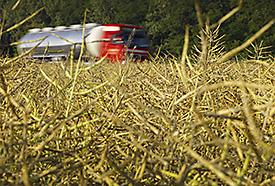Press release from 14th January 2015:
Renewable resources reach their limits
Humanity should use planetary resources with care
Can the world continue expanding its use of renewable resources at an increasing rate? Most likely not. Using a data set of over 25 resources researchers at the Helmholtz Centre for Environmental Research (UFZ), Yale University and Michigan State University demonstrate that several key resources have recently passed, at around the same time, their "peak-rate year" -- the maximum increase year. A potential implication is that as substitution becomes arduous, global society’s expanding needs will be harder to fill. They explain this in an article published in the latest issue of the international journal Ecology and Society, and featured in the journal Nature’s Research Highlights this week.
Landscape ecologists Prof. Dr. Ralf Seppelt, Dr. Ameur M. Manceur and plant ecologist Dr. Stefan Klotz from the UFZ analysed the production and extraction rates of 27 global renewable and non-renewable resources together with economist Dr. Eli Fenichel from Yale University and sustainability scholar Dr. Jianguo Liu from Michigan State University. They examined 20 renewable resources, such as maize, rice, wheat or soya, which represent around 45% of the global calorie intake according to the Food and Agriculture Organisation of the United Nations (FAO of the UN), as well as animal products, such as fish, meat, milk and egg. For 18 of these renewable resources the annual growth rate (for example the increase in meat production or in fish catch) reached its peak -- the peak-rate year -- around 2006 a few years ago.
The term peak in the context of resource use is not new as it was popularized in the discussion about peak oil initiated in the mid-1970s. The peak oil analysis of the mid 1970s alleged that the crude oil extraction rate would significantly decline after a given year. Whether such a decline will happen and what would be the ultimate cause has been hotly debated among scientists. Though oil production has actually continued to expand, other resources have followed such a pattern. UFZ researchers used a dataset of more than 25 resources and made limited assumptions, relying on computer power to extract pattern from the database. "For many resources, but not oil, we indeed observed a peak pattern", states Dr. Seppelt.
Surprisingly, they discovered not only that 20 resources had a peak-year but also that for 16 of the 20 resources with a peak-year, the peak-year lay between 1988 and 2008 -- a very narrow range in the history of humanity! "The key commodities that a person needs for food and must harvest are limited", summarizes Dr. Seppelt, Head of the Landscape Ecology Department at the UFZ. Renewable resources become scarcer. The authors were able to illustrate this using a various examples: The maximum global growth rate in crop yields for soya beans was in 2009, for milk it was 2004, for eggs it was 1993 and for the fish caught it was 1988. Data from other studies confirm these results. For example, the crop yield per area with maize, wheat, soya and rice on more than a quarter of the farming area around the world is stagnating or decreasing according to the US scientists.
Dr. Seppelt gives explanations for why many of the peak-year are synchronized – they occur at about the same time. The global population growth is a major driver. Due to the rising population and change in
diet in some regions of the world over the past few decades, such as India and China, the demand for renewable resources increased and thus the pressure to produce as much food as possible. These findings can
also be illustrated in other aspects of resource use: the team found the highest rate of increase in the cultivation of arable land to be in the 1950s; the peak for human-made irrigation areas then followed in
the 1970s, and the peak for nitrogen fertilisers was subsequently in the 1980s. "This shows that the land available for agriculture was used more intensively for growing food", conclude Dr. Klotz, Head of the
Department of Community Ecology. However, they can no longer see major opportunities for the intensification of farming. "Experts see opportunities for further increases in agricultural yield of about one to
two percent per year due to better breeding techniques and genetically modified organisms", states Dr. Seppelt. But then it will be tight: "The global community needs to accept that renewable raw materials are
also reaching their yield limits worldwide".
Not all resources have passed their peak-year. For example fish obtained from aquaculture (not caught fish from the wild) is an expanding resource. However, "the environmental cost of aquaculture is hotly debated ", mentions Dr. Seppelt.
Conclusions of global relevance can be drawn from the study "We are facing enormous challenges that affect the majority of the resources that we use", states Dr. Seppelt. Indeed, the synchrony of peak-years casts doubts on the notion that as resources become scarcer or less accessible, they can be replaced by other resources ad infinitum. As the foundation of humanity’s current standard of living is eroding, it becomes essential to take action by using fertilizer and water more efficiently for example. "At the individual level, we can start by preferring a vegetarian diet, or eating chicken instead of beef", opines Dr. Seppelt.
Publication:
Seppelt, R., A. M. Manceur, J. Liu, E. P. Fenichel, and S. Klotz. 2014. Synchronized peak-rate years of global resources use. Ecology and Society 19(4): 50.
http://dx.doi.org/10.5751/ES-07039-190450
The work was funded under the Helmholtz Program "Terrestrial Environmental Research," U.S. National Science Foundation, and Michigan AgBioResearch. This article contributed to the Global Land Project
www.globallandproject.org
Research Highlights - Selections from the scientific literature: Resource use peaks worldwide. Nature 517, 246-247 (15 January 2015) doi:10.1038/517246e.
hhttp://www.nature.com/nature/journal/v517/n7534/full/517246e.html
Further information:
Prof. Dr. Ralf Seppelt
Helmholtz Centre for Environmental Research (UFZ)
Phone: ++49(0)341-235-1250
http://www.ufz.de/index.php?de=13905
und
Dr. Stefan Klotz
Helmholtz Centre for Environmental Research (UFZ)
Phone: ++49(0)345-558-5302
http://www.ufz.de/index.php?de=14699
or via
Tilo Arnhold, Susanne Hufe (UFZ Press Office)
Phone: ++49(0)341-235-1635, -1630
Links:
GLUES – Global Assessment of Land Use Dynamics, Greenhouse Gas Emissions and Ecosystem Services. Scientific Coordination, Moderation and Synthesis
http://modul-a.nachhaltiges-landmanagement.de/de/wissenschaftliche-begleitung-glues/
of the BMBF-Research Programme „Sustainable Land Management“
http://nachhaltiges-landmanagement.de/
In the Helmholtz Centre for Environmental Research (UFZ), scientists conduct research into the causes and consequences of far-reaching environmental changes. Their areas of study cover water resources, biodiversity, the consequences of climate change and possible adaptation strategies, environmental technologies and biotechnologies, bio-energy, the effects of chemicals in the environment and the way they influence health, modelling and social-scientific issues. Its guiding principle: Our research contributes to the sustainable use of natural resources and helps to provide long-term protection for these vital assets in the face of global change. The UFZ employs more than 1,100 staff at its sites in Leipzig, Halle and Magdeburg. It is funded by the federal government, Saxony and Saxony-Anhalt.
The Helmholtz Association contributes to solving major and urgent issues in society, science and industry through scientific excellence in six research areas: Energy, earth and environment, health, key technologies, structure of matter as well as aviation, aerospace and transportation. The Helmholtz Association is the largest scientific organisation in Germany, with 35,000 employees in 18 research centres and an annual budget of around €3.8 billion. Its work is carried out in the tradition of the great natural scientist Hermann von Helmholtz (1821-1894).


